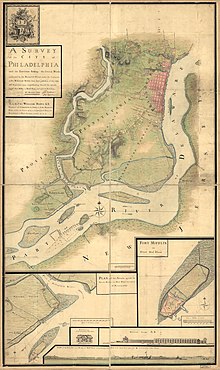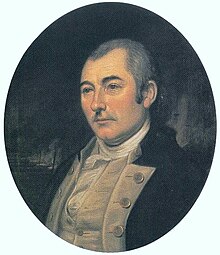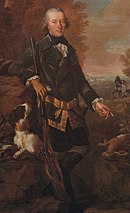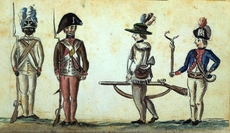
The Battle of Long Island, also known as the Battle of Brooklyn and the Battle of Brooklyn Heights, was an action of the American Revolutionary War fought on August 27, 1776, at the western edge of Long Island in present-day Brooklyn. The British defeated the Continental Army and gained access to the strategically important Port of New York, which they held for the rest of the war. It was the first major battle to take place after the United States declared its independence on July 4, 1776, in Philadelphia. It was the largest battle of the Revolutionary War in terms of both troop deployment and combat.

John Hazelwood served as a Commodore in the Pennsylvania Navy and Continental Navy and was among the most noted naval officers during the American Revolutionary War. Born in England about 1726, he became a mariner and settled in Philadelphia early in life, became married and had several children. Promoted to Commodore during the Philadelphia campaign, he also became commander of Fort Mifflin while it was under siege by the British. Throughout the campaign Hazelwood and General Washington were in frequent communication with letters. During the weeks spent engaging the British navy on the Delaware River Hazelwood innovated many naval tactics, kept the British navy at bay for weeks and played a major role in the development of riverine warfare for the American navies. Recommended by Washington and his council, Hazelwood was chosen to lead a large fleet of American ships and riverboats up river to safety. For his bravery and distinguished service Congress awarded him with a ceremonial military sword, while the famous presidential artist Charles Peale found Hazelwood worthy enough to paint his portrait. After the Revolution Hazelwood lived out his remaining years in Philadelphia.

Fort Mifflin, originally called Fort Island Battery and also known as Mud Island Fort, was commissioned in 1771 and sits on Mud Island on the Delaware River below Philadelphia, Pennsylvania near Philadelphia International Airport.
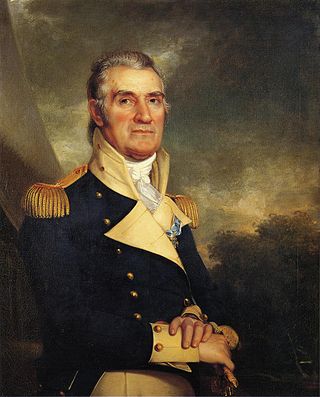
Samuel Smith was an American Senator and Representative from Maryland, a mayor of Baltimore, Maryland, and a general in the Maryland militia. He was the older brother of cabinet secretary Robert Smith.

The Pennsylvania Navy served as the naval force of Pennsylvania during the American Revolution and afterward, until the formation of the United States Navy. The navy's vessels served almost exclusively on the Delaware River, and were active in first defending the approaches to the city of Philadelphia during the British campaign that successfully occupied the city in 1777, and then preventing the Royal Navy from resupplying the occupying army.
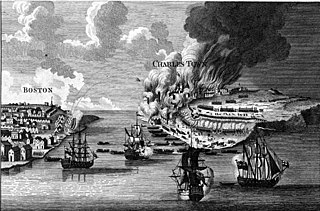
HMS Somerset was a 70-gun third-rate ship of the line of the Royal Navy, built at Chatham Dockyard to the draught specified by the 1745 Establishment, and launched on 18 July 1748. She was the third vessel of the Royal Navy to bear the name. Somerset was involved in several notable battles of the Seven Years' War and the American Revolutionary War. She was wrecked in a storm in 1778 when she ran aground off of Provincetown, on Cape Cod, Massachusetts.

The Battle of White Marsh or Battle of Edge Hill was a battle of the Philadelphia campaign of the American Revolutionary War fought December 5–8, 1777, in the area surrounding Whitemarsh Township, Pennsylvania. The battle, which took the form of a series of skirmish actions, was the last major engagement of 1777 between British and American forces.

The Battle of Red Bank, also known as the Battle of Fort Mercer, was a battle fought on October 22, 1777, during the American Revolutionary War. A British and Hessian force was sent to take Fort Mercer on the left bank of the Delaware River just south of Philadelphia, but was decisively defeated by an inferior force of colonial defenders. Although the British did take Fort Mercer a month later, the victory supplied a sorely-needed morale boost to the American cause, delayed British plans to consolidate gains in Philadelphia, and relieved pressure on General George Washington's army to the north of the city.

HMS Augusta was a 64-gun third rate ship of the line of the Royal Navy, launched on 24 October 1763 at Rotherhithe.

Fort Mercer was an earthen fort on the Delaware River on its New Jersey shore constructed by the Continental Army during the American Revolutionary War. Built by Polish engineer Thaddeus Kosciuszko under the command of George Washington, Fort Mercer was built in 1777 to block the approach to Philadelphia, Pennsylvania in concert with Fort Mifflin on the Pennsylvania side.

Francis Reynolds-Moreton, 3rd Baron Ducie was a British Royal Navy officer, peer and politician who participated in numerous engagements during the American War of Independence. He is largely noted for his role conflict at the Battle of Red Bank in 1777 during the Philadelphia campaign, involving the dual siege of Fort Mifflin and Fort Mercer. During this operation he was commander of the advance fleet on board HMS Augusta in an attempt to clear the way along the Delaware to Philadelphia. His ship ran aground while being pursued by Commodore Hazelwood's fleet when the vessel mysteriously caught fire shortly thereafter and exploded before all of the crew could abandon ship. Reynolds also commanded HMS Jupiter and HMS Monarch in several operations and saw service against the French in the North Sea, European Atlantic coast and the Caribbean theaters.
Simeon Thayer fought in Rogers' Rangers during the French and Indian War and made a harrowing escape from French-allied Indians. At the outbreak of the American Revolutionary War, the Rhode Island assembly appointed him an officer. He quickly raised a company of soldiers and marched with them to the Siege of Boston. He and his men went on Benedict Arnold's expedition to Quebec during which time he kept a journal of his experiences. He fought at Quebec and was captured. After being paroled, he again served as an officer in the Continental Army. Simeon Thayer was a member of the Society of the Cincinnati of the State of Rhode Island.

At the Battle of Brandywine on September 11, 1777 a colonial American army led by General George Washington fought a British-Hessian army commanded by General William Howe, 5th Viscount Howe. Washington drew up his troops in a defensive position behind Brandywine Creek. Howe sent Lieutenant General Wilhelm von Knyphausen's 5,000 troops to demonstrate against the American front at Chadd's Ford. Meanwhile, Lieutenant General Charles Cornwallis took 10,000 troops on a wide flank march that crossed the creek and got in the rear of the American right wing under Major General John Sullivan. The Americans changed front but Howe's attack broke through.

Sir George Osborn, 4th Baronet was a British Army officer and politician. He fought in the American Revolutionary War as a British officer. He served in the House of Commons from 1769 to 1784 - before, during, and after that conflict. In 1777 he led a detachment of the Guards Brigade at the battles of Brandywine and Germantown. Besides his combat duties, he served as the inspector of the Hessian mercenary soldiers. After returning from America in 1777 he was promoted in rank to general officer. In 1787 he received advancement to lieutenant general. He is remembered in United States history for a clever but harsh comment that he made concerning the dead body of an American officer.
The 4th Continental Artillery Regiment, also known as Reign's Continental Artillery Regiment, was an American military unit during the American Revolutionary War. The regiment became part of the Continental Army on 10 June 1777 as Colonel Thomas Proctor's Continental Artillery Regiment. It was made up of eight artillery companies from eastern Pennsylvania. At the time of the regiment's formation, two companies were already in existence, one from as early as October 1775. One company served at Trenton in December 1776 where it performed well in action. In February 1777, Pennsylvania expanded its two-company battalion into an eight-company regiment. After officially joining the Continental Army, the regiment saw much fighting in the Philadelphia campaign in late 1777. Elements of Proctor's Regiment fought at Monmouth in June 1778 and joined the Sullivan Expedition in summer 1779.

Thomas-Antoine de Mauduit du Plessis or Thomas Duplessis or Thomas-Antoine du Plessis-Mauduit was a French officer who fought with the Continental Army during the American Revolutionary War. Born in Brittany, he ran away to sea at age 12 and voyaged in the eastern Mediterranean Sea for a time. Later, he attended a famous French artillery school. He was among a number of volunteers to join the fledgling American army in 1777, especially distinguishing himself for bravery at Germantown and skill at Red Bank. At Valley Forge he helped train American officers in the finer points of tactics and artillery handling.
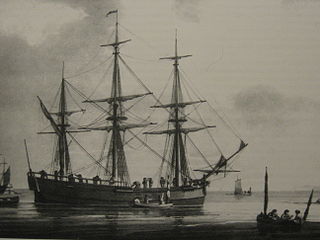
HMS Vigilant was the merchantman Grand Duchess of Russia, converted into a warship during the American Revolution. She served as a transport in North American waters from 1775. The Royal Navy (RN) purchased her in 1777, named her HMS Vigilant, and modified her for shore bombardment duties. She was instrumental in the eventual British success during the siege of Fort Mifflin that same year and supported British operations in Georgia and South Carolina in 1779–80. Her heavy armament proved to be more than Vigilant was designed to handle and she was condemned and burnt in 1780.

HMS Roebuck was a fifth-rate ship of the Royal Navy which served in the American and French Revolutionary Wars. Designed in 1769 by Sir Thomas Slade to operate in the shallower waters of North America, she joined Lord Howe's squadron towards the end of 1775 and took part in operations against New York the following year. She engaged the American gun batteries at Red Hook during the Battle of Long Island in August 1776, and forced a passage up the Hudson River in October. On 25 August 1777, Roebuck escorted troopships to Turkey Point, Maryland, where an army was landed for an assault on Philadelphia. She was again called upon to accompany troopships in December 1779, this time for an attack on Charleston. When the ships-of-the-line, which were too large to enter the harbour, were sent back to New York, Admiral Marriot Arbuthnot made Roebuck his flagship. She was, therefore, at the front of the attack, leading the British squadron across the shoal to engage Fort Moultrie and the American ships beyond.
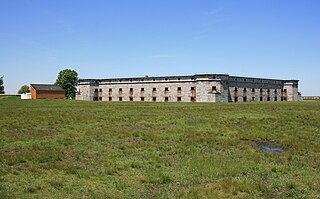
HMS Merlin was a sloop of war, bearing sixteen guns, commanded by Samuel Reeve, and saw service during the American Revolutionary War.
Jackson, John, Fort Mifflin: Valiant Defender of the Delaware James & Sons, Norristown, PA; 1986, 206 pages



